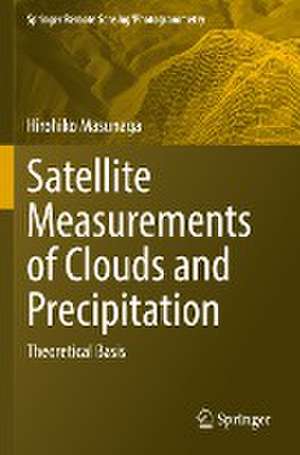Satellite Measurements of Clouds and Precipitation: Theoretical Basis: Springer Remote Sensing/Photogrammetry
Autor Hirohiko Masunagaen Limba Engleză Paperback – 28 apr 2023
This book provides a thorough introductory description of the physical principles underlying the satellite remote sensing of clouds and precipitation. A diverse collection of satellite sensors is covered, including imagers, radars, and sounders over a broad spectral range from visible to microwave radiation.
The progress in satellite instrument technology during the past two decades as represented by the Tropical Rainfall Measuring Mission (TRMM), CloudSat, and Global Measurement Mission (GPM) satellites has drastically improved our capability of measuring clouds and precipitation across the globe. At the same time, such rapid progress makes it increasingly challenging for scientists without specialized skills in remote sensing to fully grasp how satellite measurements are being made. This book is designed to mitigate that challenge. The targeted readers are graduate students and professional scientists seeking an extended summary of the theoretical background behind observations from space, ranging from fundamental physics (the statistical mechanics and radiative processes, for instance) to more practical levels of theory such as retrieval algorithm design.| Toate formatele și edițiile | Preț | Express |
|---|---|---|
| Paperback (1) | 892.46 lei 43-57 zile | |
| Springer Nature Singapore – 28 apr 2023 | 892.46 lei 43-57 zile | |
| Hardback (1) | 897.02 lei 43-57 zile | |
| Springer Nature Singapore – 27 apr 2022 | 897.02 lei 43-57 zile |
Din seria Springer Remote Sensing/Photogrammetry
- 15%
 Preț: 653.98 lei
Preț: 653.98 lei - 24%
 Preț: 847.78 lei
Preț: 847.78 lei - 24%
 Preț: 911.54 lei
Preț: 911.54 lei - 15%
 Preț: 644.18 lei
Preț: 644.18 lei - 24%
 Preț: 694.68 lei
Preț: 694.68 lei - 18%
 Preț: 785.11 lei
Preț: 785.11 lei - 18%
 Preț: 950.52 lei
Preț: 950.52 lei - 18%
 Preț: 895.58 lei
Preț: 895.58 lei - 18%
 Preț: 1112.60 lei
Preț: 1112.60 lei - 18%
 Preț: 946.87 lei
Preț: 946.87 lei - 18%
 Preț: 1244.71 lei
Preț: 1244.71 lei - 18%
 Preț: 1114.02 lei
Preț: 1114.02 lei - 24%
 Preț: 728.29 lei
Preț: 728.29 lei - 24%
 Preț: 895.51 lei
Preț: 895.51 lei - 18%
 Preț: 1105.83 lei
Preț: 1105.83 lei - 20%
 Preț: 560.05 lei
Preț: 560.05 lei - 18%
 Preț: 1043.14 lei
Preț: 1043.14 lei - 18%
 Preț: 944.34 lei
Preț: 944.34 lei - 18%
 Preț: 888.18 lei
Preț: 888.18 lei - 18%
 Preț: 1005.61 lei
Preț: 1005.61 lei - 24%
 Preț: 844.06 lei
Preț: 844.06 lei
Preț: 892.46 lei
Preț vechi: 1088.37 lei
-18% Nou
Puncte Express: 1339
Preț estimativ în valută:
170.77€ • 178.75$ • 142.14£
170.77€ • 178.75$ • 142.14£
Carte tipărită la comandă
Livrare economică 31 martie-14 aprilie
Preluare comenzi: 021 569.72.76
Specificații
ISBN-13: 9789811922459
ISBN-10: 9811922454
Pagini: 297
Ilustrații: XVII, 297 p. 106 illus., 52 illus. in color.
Dimensiuni: 155 x 235 mm
Greutate: 0.49 kg
Ediția:1st ed. 2022
Editura: Springer Nature Singapore
Colecția Springer
Seria Springer Remote Sensing/Photogrammetry
Locul publicării:Singapore, Singapore
ISBN-10: 9811922454
Pagini: 297
Ilustrații: XVII, 297 p. 106 illus., 52 illus. in color.
Dimensiuni: 155 x 235 mm
Greutate: 0.49 kg
Ediția:1st ed. 2022
Editura: Springer Nature Singapore
Colecția Springer
Seria Springer Remote Sensing/Photogrammetry
Locul publicării:Singapore, Singapore
Cuprins
Introduction.- Satellite Missions and Instruments.- Satellite Orbit and Scan.- Principles of Statistical Mechanics.- Principles of Electrodynamics and Geometrical Optics.- General Theory of Radiative Processes.- Infrared Sensing.- Visible/Near-infrared Imaging.- Microwave Radiometry.- Active Remote Sensing.- Mathematical Basis of Retrieval Algorithms.- Global datasets of clouds and precipitation.- Satellite Data Simulators.
Notă biografică
Hirohiko Masunaga is an associate professor at the Institute for Space–Earth Environmental Research (ISEE) of Nagoya University. After earning his Ph.D. in astronomy from The University of Tokyo, he pursued his career as an atmospheric scientist there in the National Aerospace Development Administration (NASDA, currently the Japan Aerospace Exploration Agency, or JAXA) and at Colorado State University before he joined Nagoya University in 2006. His research interests include satellite meteorology and climatology, tropical convection and large-scale dynamics, tropical air–sea interactions, and the development of a satellite data simulator. In his recent work, he devised a novel methodology to coordinate the observations from different satellites beyond their individual instrument capabilities in order to explore the dynamics of tropical moist convection.
Textul de pe ultima copertă
This book provides a thorough introductory description of the physical principles underlying the satellite remote sensing of clouds and precipitation. A diverse collection of satellite sensors is covered, including imagers, radars, and sounders over a broad spectral range from visible to microwave radiation.
The progress in satellite instrument technology during the past two decades as represented by the Tropical Rainfall Measuring Mission (TRMM), CloudSat, and Global Measurement Mission (GPM) satellites has drastically improved our capability of measuring clouds and precipitation across the globe. At the same time, such rapid progress makes it increasingly challenging for scientists without specialized skills in remote sensing to fully grasp how satellite measurements are being made. This book is designed to mitigate that challenge. The targeted readers are graduate students and professional scientists seeking an extended summary of the theoretical background behind observations from space, ranging from fundamental physics (the statistical mechanics and radiative processes, for instance) to more practical levels of theory such as retrieval algorithm design.Caracteristici
Offers an introductory course in satellite remote sensing using state-of-the-art instruments Provides different layers of theoretical background from underlying physics to retrieval methodology Organizes both the basic principles and applications into separate, stand-alone sets of chapters
